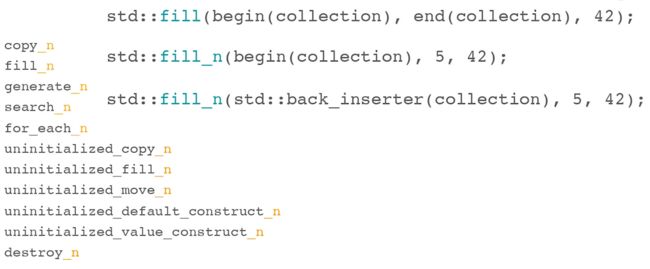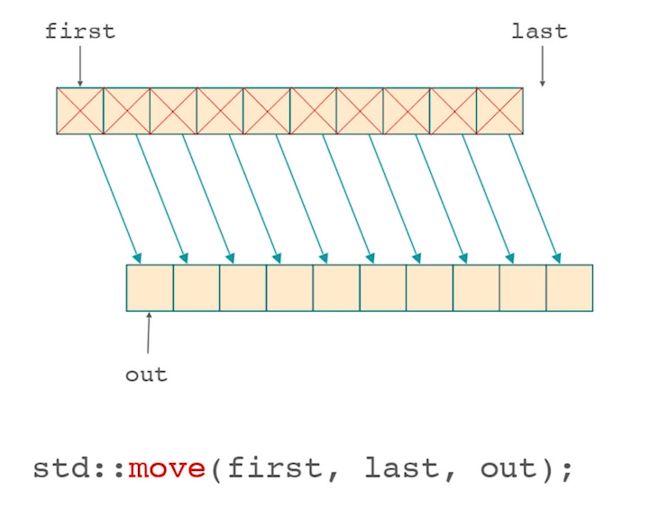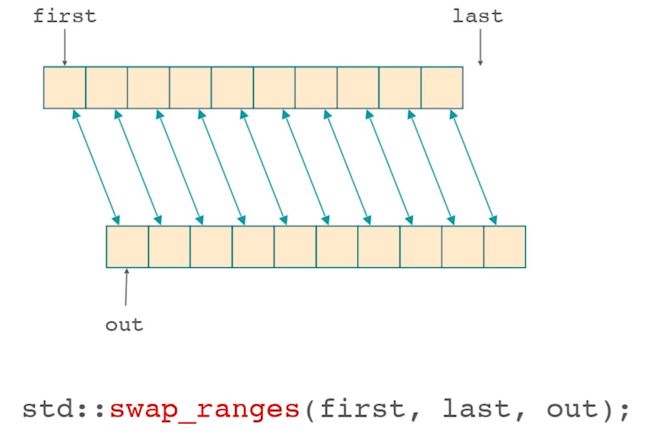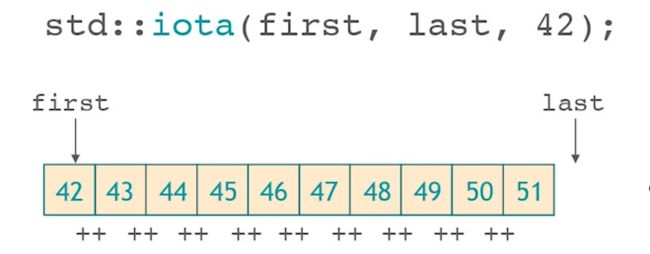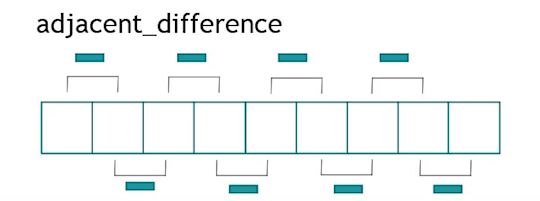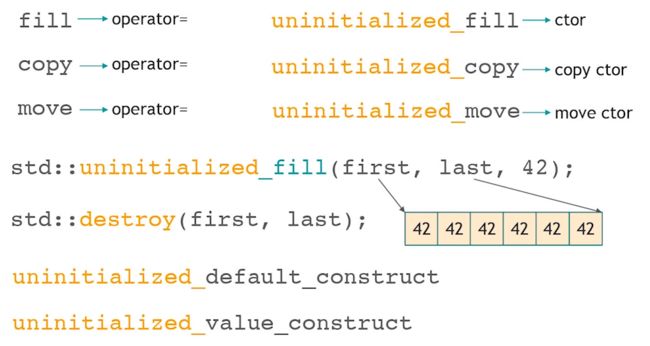图解STL中算法的分类、简介及其Demo
STL中包含算法头文件
- 不改变序列的操作
- 改变序列的操作
- 划分操作
- 排序操作
- 二分操作
- 合并操作
- 比较操作
- 集合操作
- 堆操作
- 最大最小值操作
- 排列操作
- 数值操作
- 未初始化内存上的操作
这里不说具体怎么使用每个算法,但是使用的Demo会给出来,使用方法都可以在https://en.cppreference.com查到;这里也不说每个算法的实现原理,实现原理后面还会写博客说的。
来张总结图吧,可以对函数有个大体的印象。
先说明下,算法中带_if后缀的表示可自定义条件,带_copy后缀的表示把结果放入新的序列中,带_n后缀的表示操作相同元素n次。
*_n:
这些都是标准库的带后缀的例子,在下面的博文中,不会对这些内容再过多赘述。
不改变序列的操作
all_ofany_ofnone_ofcountcount_iffindfind_iffind_if_notadjacent_findsearchsearch_n
(all / any / none)_of
这是C++11新增的三个算法,分别表示序列上所有的元素全部都是……,存在一个是……,没有一个是……。
find / count / search
count对序列中指定元素进行计数,加了_if的版本可以自定义计数条件;
find在序列中顺序查找一个元素,同理,加了_if的版本可以自定义查找条件,_if_not(C++11)是_if的方面,把查找条件取反;
search在序列中查找一段连续子序列,加了_n表示在序列中查找一段连续相同的子序列。
adjacent_find
在序列中找到第一个挨在一起的两个一样值的指定元素,看图就明白了。
Demo
void NonModifySequenceDemo()
{
std::vector result {2, 0, 4, 8, 6};
std::cout << "{2, 0, 4, 8, 6} all_of even " << std::boolalpha <<
std::all_of(std::begin(result), std::end(result), [] (const int & ele)
{
return ele % 2 == 0;
}) << std::endl;
for_each(std::begin(result), std::end(result), [] (int & ele)
{
--ele;
});
std::cout << "{1, -1, 3, 7, 5} any_of even " << std::boolalpha <<
std::any_of(std::begin(result), std::end(result), [] (const int & ele)
{
return ele % 2 == 0;
}) << std::endl;
std::cout << "{1, -1, 3, 7, 5} none_of even " << std::boolalpha <<
std::none_of(std::begin(result), std::end(result), [] (const int & ele)
{
return ele % 2 == 0;
}) << std::endl;
std::cout << "{1, -1, 3, 7, 5} has " <<
std::count(std::begin(result), std::end(result), 1) << " numbers of 1" << std::endl;
std::cout << "{1, -1, 3, 7, 5} has " <<
std::count_if(std::begin(result), std::end(result), [] (const int & ele)
{
return ele % 2;
}) << " numbers of odd" << std::endl;
std::cout << "{1, -1, 3, 7, 5} the first equal 3 at " <<
std::find(std::begin(result), std::end(result), 3) - std::begin(result) <<
" index" << std::endl;
std::cout << "{1, -1, 3, 7, 5} the first greater 6 at " <<
std::find_if(std::begin(result), std::end(result), [] (const int & ele)
{
return ele > 6;
}) - std::begin(result) << " index" << std::endl;
std::cout << "{1, -1, 3, 7, 5} the first not greater 0 at " <<
std::find_if_not(std::begin(result), std::end(result), [] (const int & ele)
{
return ele > 0;
}) - std::begin(result) << " index" << std::endl;
result[3] = 3;
std::cout << "{1, -1, 3, 3, 5} adjacent equal value is " <<
*std::adjacent_find(std::begin(result), std::end(result)) <<
std::endl;
result.clear();
result = {4, 3, 6, 6, 6, 6, 9, 1, 2, 4, 10};
std::vector tag {1, 2, 4};
std::cout << "{4, 3, 6, 6, 6, 6, 9, 1, 2, 4, 10} include {1, 2, 4} at " <<
std::search(std::begin(result), std::end(result),
std::begin(tag), std::end(tag)) - std::begin(result) <<
" index" << std::endl;
std::cout << "{4, 3, 6, 6, 6, 6, 9, 1, 2, 4, 10} include 4 numbers of six at " <<
std::search_n(std::begin(result), std::end(result),
4, 6) - std::begin(result) <<
" index" << std::endl;
}
改变序列的操作
copy / copy_backwardcopy_if / copy_n(C++11)move / move_backward(C++11)fill / fill_ntransformgenerate / generate_nremove / remove_if / remove_copy / remove_copy_ifreplace / replace_if / replace_copy / replace_copy_ifreverse / reverse_copyrotate / rotate_copyunique / unique_copyswap / iter_swap / swap_rangesshuffle(C++11)sample(C++17)
改变序列的算法最多了,相应地,这些操作都提供了几个待后缀的函数。
先来讲几个常见的同时也是用得比较多的。
copy
复制。
move
这个move并不是取得一个值的右值引用,而是取得整个序列的右值引用。
swap_ranges
交换两个序列的内容。
类似的还有swap,这个用得最多;iter_swap可以交换指针或者迭代器指向内存的内容。
fill
类似memset。
generate
这个和fill挺像,只不过generate使用一个函数往序列中填充元素,也就是说你可以定制这个序列。
iota
iota的功能是在一段区间上填上递增的数字。
下面是我绘制的图:
remove
不,它只是把要删除的元素移动到了序列尾。
unique
删除序列中连续重复的内容,和remove类似,只是把冗余的元素移动过了序列尾。
注意,上图中并没有删除最后一个99,如果想要删除序列中重复的内容,需要先对序列调用std::sort使冗余的元素聚集在一起。
transform
对序列中的每个元素都执行函数f,可以对序列本身没有影响,也可以改变序列本身。看看transform的声明就知道了。
template< class InputIt, class OutputIt, class UnaryOperation >
OutputIt transform( InputIt first1, InputIt last1, OutputIt d_first,
UnaryOperation unary_op );
for_each
和transform有点像,它也是对序列执行函数f。只不过for_each在本序列上进行操作,它没有transform的灵活性,因此对序列产生副作用的机率很大。也看看这个算法的声明:
template< class InputIt, class UnaryFunction >
UnaryFunction for_each( InputIt first, InputIt last, UnaryFunction f );
rotate
在序列中交换其中的两部分的顺序。
reverse
反转序列。
shuffle
正如下图所示,有一个骰子,对一个序列调用shuffle会随机打乱这个序列元素之间的顺序。
sample
这是C++17的内容,作用是从序列中随机挑选n个元素出来组成新的序列,每个元素只会被选择一次,如果n大于序列的长度,那么整个序列都会被选出来。
Demo
void ModifySequenceDemo()
{
static const int LEN = 10;
std::vector res(5), aux(LEN);
std::iota(res.begin(), res.end(), 1);
std::copy(res.begin(), res.end(), aux.begin());
std::cout << "copy {1, 2, 3, 4, 5} to aux(10) : {";
for (auto it = aux.begin(); it != aux.end(); std::cout << *it <<
std::array{", ", "}\n"}[it + 1 == aux.end()], ++it) {}
aux.clear(), aux.resize(LEN, 0);
std::copy_backward(res.begin(), res.end(), aux.end());
std::cout << "copy_backward {1, 2, 3, 4, 5} to aux(10) : {";
for (auto it = aux.begin(); it != aux.end(); std::cout << *it <<
std::array{", ", "}\n"}[it + 1 == aux.end()], ++it) {}
aux.clear(), aux.resize(LEN, 0);
std::copy_if(res.begin(), res.end(), aux.begin(), [] (const int & ele)
{
return ele % 2;
});
std::cout << "copy_if {1, 2, 3, 4, 5} to aux(10) : {";
for (auto it = aux.begin(); it != aux.end(); std::cout << *it <<
std::array{", ", "}\n"}[it + 1 == aux.end()], ++it) {}
aux.clear(), aux.resize(LEN, 0);
std::copy_n(res.begin(), 3, aux.end());
std::cout << "copy_n(3) {1, 2, 3, 4, 5} to aux(10) : {";
for (auto it = aux.begin(); it != aux.end(); std::cout << *it <<
std::array{", ", "}\n"}[it + 1 == aux.end()], ++it) {}
std::fill_n(res.begin(), 3, 3);
std::cout << "fill_n(3) {1, 2, 3, 4, 5} : {";
for (auto it = res.begin(); it != res.end(); std::cout << *it <<
std::array{", ", "}\n"}[it + 1 == res.end()], ++it) {}
res.clear(), res.resize(LEN >> 1, 0);
std::fill(res.begin(), res.end(), 0);
std::cout << "fill {} by 0 : {";
for (auto it = res.begin(); it != res.end(); std::cout << *it <<
std::array{", ", "}\n"}[it + 1 == res.end()], ++it) {}
// res.clear(), res.resize(LEN >> 1, 0);
std::transform(res.begin(), res.end(), res.begin(), [] (const int & ele)
{
return ele + 1;
});
std::cout << "transform {0, 0, 0, 0, 0} to {1, 1, 1, 1, 1} : {";
for (auto it = res.begin(); it != res.end(); std::cout << *it <<
std::array{", ", "}\n"}[it + 1 == res.end()], ++it) {}
res.clear(), res.resize(LEN >> 1, 0);
std::generate(res.begin(), res.end(), [] ()
{
static int cnt = 1;
return cnt++;
});
std::cout << "generate {} : {";
for (auto it = res.begin(); it != res.end(); std::cout << *it <<
std::array{", ", "}\n"}[it + 1 == res.end()], ++it) {}
res.clear(), res.resize(LEN >> 1, 0);
std::generate_n(res.begin(), LEN >> 1, [] ()
{
return std::rand() & 0x7fffffff;
});
std::cout << "generate_n {} random : {";
for (auto it = res.begin(); it != res.end(); std::cout << *it <<
std::array{", ", "}\n"}[it + 1 == res.end()], ++it) {}
res.clear(), res.resize(LEN >> 1, 0);
res = {5, 5, 5, 4, 5};
res.erase(std::remove(res.begin(), res.end(), 5), res.end());
std::cout << "remove 5 from {5, 5, 5, 4, 5} : {";
for (auto it = res.begin(); it != res.end(); std::cout << *it <<
std::array{", ", "}\n"}[it + 1 == res.end()], ++it) {}
res = {5, 1, 5, 4, 5};
std::replace(res.begin(), res.end(), 5, 6);
std::cout << "repalce 5 with 6 from {5, 1, 5, 4, 5} : {";
for (auto it = res.begin(); it != res.end(); std::cout << *it <<
std::array{", ", "}\n"}[it + 1 == res.end()], ++it) {}
res = {1, 2, 3, 4, 5};
std::reverse(res.begin(), res.end());
std::cout << "reverse {1, 2, 3, 4, 5} : {";
for (auto it = res.begin(); it != res.end(); std::cout << *it <<
std::array{", ", "}\n"}[it + 1 == res.end()], ++it) {}
res = {1, 2, 3, 4, 5};
std::rotate(res.begin(), res.begin() + 2, res.end());
std::cout << "rotate {1, 2, 3, 4, 5} that {1, 2}, {3, 4, 5} : {";
for (auto it = res.begin(); it != res.end(); std::cout << *it <<
std::array{", ", "}\n"}[it + 1 == res.end()], ++it) {}
res = {5, 5, 5, 4, 5};
res.erase(std::unique(res.begin(), res.end()), res.end());
std::cout << "unique from {5, 5, 5, 4, 5} : {";
for (auto it = res.begin(); it != res.end(); std::cout << *it <<
std::array{", ", "}\n"}[it + 1 == res.end()], ++it) {}
res = {1, 2, 3, 4, 5};
std::shuffle(res.begin(), res.end(), std::mt19937{std::random_device{}()});
std::cout << "shuffle {1, 2, 3, 4, 5} : {";
for (auto it = res.begin(); it != res.end(); std::cout << *it <<
std::array{", ", "}\n"}[it + 1 == res.end()], ++it) {}
#if __cplusplus >= 201702L
res = {1, 2, 3, 4, 5};
aux.clear();
std::sample(res.begin(), res.end(),
std::back_inserter(aux),
3,
std::mt19937{std::random_device{}()});
std::cout << "sample {5, 1, 5, 4, 5} 3 elements: {";
for (auto it = aux.begin(); it != aux.end(); std::cout << *it <<
std::array{", ", "}\n"}[it + 1 == res.end()], ++it) {}
#endif // __cplusplus
}
划分操作
partitionstable_partitionis_partitioned(从此向下都是C++11的新增算法)partition_copypartition_point
上面就是划分,把奇数和偶数划分开来,可以看到,statble_partition划分的时候可以保持序列之前的相对顺序,而partition就会破坏这种相对顺序。
partition_point
C++11新增算法。这个算法会返回划分的界限,且这个算法针对已经划分好的元素有效,虽然说partition的返回值就是划分点,但是如果没有保存这个点,过一段之间后又想知道划分点,这个时候就只能遍历了,由于划分后的序列满足二分条件,因此partition_point就出来了。二分找到划分点。
Demo
void PartialDemo()
{
std::vector res {2, 1, 0, 3, 3, 5, 8};
std::vector aux(res);
std::cout << "{2, 1, 0, 3, 3, 5, 8} partition :" << std::endl;
auto pre = std::partition(std::begin(aux), std::end(aux), [] (const int & ele)
{
return ele % 2;
});
auto now = std::partition_point(std::begin(aux), std::end(aux), [] (const int & ele)
{
return ele % 2;
});
assert(&*pre == &*now);
std::cout << "\tpartition_point at index of " << now - std::begin(aux) << std::endl;
std::cout << "\tnon-stable : {";
for (auto it = aux.begin(); it != aux.end(); std::cout << *it <<
std::array{", ", "}\n"}[it + 1 == aux.end()], ++it) {}
aux.assign(std::begin(res), std::end(res));
std::stable_partition(std::begin(aux), std::end(aux), [] (const int & ele)
{
return ele % 2;
});
std::cout << "\tstable : {";
for (auto it = aux.begin(); it != aux.end(); std::cout << *it <<
std::array{", ", "}\n"}[it + 1 == aux.end()], ++it) {}
std::cout << "{2, 1, 0, 3, 3, 5, 8} is partitioned ? " << std::boolalpha <<
std::is_partitioned(std::begin(res), std::end(res), [] (const int & ele)
{
return ele % 2;
}) << std::endl;
}
排序操作
sortstable_sortpartial_sort / partial_sort_copynth_elementis_sorted(C++11)is_sorted_until(C++11)
这是STL最精髓的部分了。也是最有味的部分,牵扯到一些思想和排序算法。
partial_sort
对序列的前部分进行排序,调用这个算法完后,可以保证前半部分一定有序,后半部分就不知道了。
nth_element
这个算法保证第n个位置上的元素一定是有序的,然后以这个位置为界限,右边的每一个元素都大于左边的每一个元素。有没有感觉这和快排的思想很像,在快排中,最理想的状态就是序列分成相等的两半,右边的元素都大于左边的元素。
用nth_element来重写快排:
template
void QuickSortBySTLnth_element(Iterator first, Iterator last)
{
if (first == last || std::next(first) == last)
return ;
std::prev(first);
Iterator mid = first + (last - first) / 2;
std::nth_element(first, mid, last);
QuickSortBySTLnth_element(first, mid);
QuickSortBySTLnth_element(mid, last);
}
以后面试要手写快排再也不用担心了。
is_sorted / is_sorted_until
这个可以参考下面的Demo和下面讲堆操作时讲到的is_heap / is_heap_until。
Demo
void SortDemo()
{
std::vector res(9);
std::iota(std::begin(res), std::end(res), 0);
auto print = [&res] (const std::string & str)
{
std::cout << str << " : ";
std::ostream_iterator oit(std::cout, " ");
std::copy(std::begin(res), std::end(res), oit);
std::cout << std::endl;
};
std::shuffle(std::begin(res), std::end(res), std::mt19937(std::random_device{}()));
print("origin sequence");
std::cout << std::boolalpha << "sequence sorted ? " <<
std::is_sorted(std::begin(res), std::end(res)) << std::endl;
std::vector other;
auto end = std::is_sorted_until(std::begin(res), std::end(res));
other.assign(std::begin(res), end);
other.swap(res);
print("max sorted sequence");
other.swap(res);
std::nth_element(std::begin(res), std::begin(res) + res.size() / 2, std::end(res));
std::cout << "the mid element is : " << *(std::begin(res) + res.size() / 2) << std::endl;
std::partial_sort(std::begin(res), std::begin(res) + res.size() / 2, std::end(res));
print("after partial_sort");
std::sort(std::begin(res), std::end(res));
print("after sort:");
// stable_sort similar sort, so omit
}
二分操作
lower_boundupper_boundbinary_searchequal_range
区间上的二分查找,很高效的算法。
Demo
这个可以参考今日头条2018校园招聘后端开发工程师(第二批)编程题 - 题解的第一题的代码。
合并操作
mergeinplace_merge
有序区间合并,而两者的区别就在于inplace_merge可以在就地进行(一个序列,前半部分和后部分分别有序)而不用借助额外的空间,而merge通常用来把不同有序序列合并,因此需要一个容器来放结果。
Demo
合并有序区间在归并排序用得挺多,因此用标准库的合并函数来重写下归并排序。
template
void MergeSortBySTLmerge(Iterator first, Iterator last)
{
if (first == last || std::next(first) == last)
return ;
std::prev(first);
Iterator mid = first + (last - first) / 2;
MergeSortBySTLmerge(first, mid);
MergeSortBySTLmerge(mid, last);
std::vector tmp;
std::merge(first, mid,
mid, last,
std::back_inserter(tmp));
std::copy(std::begin(tmp), std::end(tmp), first);
}
template
void MergeSortBySTLinpalce_merge(Iterator first, Iterator last)
{
if (first == last || std::next(first) == last)
return ;
std::prev(first);
Iterator mid = first + (last - first) / 2;
MergeSortBySTLmerge(first, mid);
MergeSortBySTLmerge(mid, last);
std::inplace_merge(first, mid, last);
}
可以看出,std::inpalce_merge在归并排序中还是好用。
比较操作
equallexicographical_comparemismatch
至少两个东西才能比较,因此,这三个算法操作的是两个序列,分别判断是否完全相同、字典序、第一个不同的地方。
Demo
注意equal和mismath这两个函数,接口的参数在C++不同版本不一样。C++14之前这两个函数默认认为两个序列的大小是相同的,因此只要传入3个参数就能正常工作。
void CompareDemo()
{
std::vector A {6, 6, 7, 6, 6};
std::vector B(A);
std::cout <<
std::boolalpha <<
std::equal(std::begin(A), std::end(A),
std::begin(B)) <<
std::endl;
#if __cplusplus >= 201402L
std::cout <<
std::boolalpha <<
std::equal(std::begin(A), std::end(A),
std::begin(B), std::end(B)) <<
std::endl;
#endif // __cplusplus
std::cout <<
std::boolalpha <<
std::equal(std::begin(A), std::begin(A) + A.size() / 2,
A.rbegin()) <<
std::endl;
++B[1];
std::cout <<
std::boolalpha <<
std::lexicographical_compare(std::begin(A), std::end(A),
std::begin(B), std::end(B)) <<
std::endl;
typedef std::vector::iterator Iter;
#if __cplusplus < 201402L
std::pair p = std::mismatch(std::begin(A), std::end(B),
std::begin(B));
#else
std::pair p = std::mismatch(std::begin(A), std::end(B),
std::begin(B), std::end(B));
#endif
std::cout <<
std::boolalpha <<
"A : " << *p.first << " diff B : " << *p.second <<
std::endl;
}
集合操作
STL把两个有序序列看成两个集合,然后这两个的”集合“可以进行如下的运算(交、并、补、查等等),看看图就明白了。
set_differenceset_unionset_intersectionset_symmetric_differencesincludesmerge
Demo
void AlgoSetDemo()
{
std::vector A {2, 1, 3, 4, 5};
std::vector B {4, 2, 10};
std::vector result;
auto print = [&result] (const std::string & str)
{
std::cout << str << " : ";
for (auto it = result.begin(); it != result.end(); ++it)
std::cout << *it << " \n"[std::next(it) == result.end()];
};
std::sort(std::begin(A), std::end(A));
std::sort(std::begin(B), std::end(B));
// A : 1 2 3 4 5
// B : 2 4 10
std::set_difference(std::begin(A), std::end(A),
std::begin(B), std::end(B),
std::back_inserter(result));
print("set_difference");
result.clear();
std::set_union(std::begin(A), std::end(A),
std::begin(B), std::end(B),
std::back_inserter(result));
print("set_union");
result.clear();
std::set_intersection(std::begin(A), std::end(A),
std::begin(B), std::end(B),
std::back_inserter(result));
print("set_intersection");
result.clear();
std::set_symmetric_difference(std::begin(A), std::end(A),
std::begin(B), std::end(B),
std::back_inserter(result));
print("set_symmetric_difference");
result.clear();
std::cout << std::boolalpha << "includes : " << std::includes(std::begin(A), std::end(A),
std::begin(B), std::end(B)) << std::endl;
std::merge(std::begin(A), std::end(A),
std::begin(B), std::end(B),
std::back_inserter(result));
print("merge");
}
堆操作
make_heappush_heappop_heapsort_heapis_heap(C++11)is_heap_until(C++11)
堆操作,建堆、向堆中压入一个元素、从堆中弹出一个元素、堆排序。这是堆的基本操作,而普通的堆是完全二叉树,可以用数组来存储,因此,C++标准库的堆操作,操作的是序列。
![]()
make_heap
把一串序列调整成最大堆的数组形式。
push_heap
pop_heap
把堆顶元素和序列尾元素交换一下,调整堆就行了。
sort_heap
明白了上面pop_heap的过程,就会发现,pop_heap不会把序列尾的元素弹出序列,因此,利用这一定可以实现堆排序,堆排序是层有序的,也就是说最大的元素在堆顶,第二大的元素在第二层,依次类推。
template
void HeapSortBypop_heap(Iterator first, Iterator last)
{
for (; first != last; std::pop_heap(first, last--)) {}
}
is_heap / is_heap_until
这是C++11的两个算法,功能是判断序列是否为最大堆以及在序列中找到一个最大的最大堆(以序列头为堆顶)。
Demo
void HeapDemo()
{
std::vector result(8);
std::iota(std::begin(result), std::end(result), 1);
auto print = [] (const std::string & str, const int & ele)
{
std::cout << str << " : " << ele << std::endl;
};
std::for_each(std::begin(result), std::end(result), std::bind(print, "origin", std::placeholders::_1));
std::cout << std::endl;
std::make_heap(std::begin(result), std::end(result));
std::for_each(std::begin(result), std::end(result), std::bind(print, "make_heap", std::placeholders::_1));
std::cout << std::endl;
result.push_back(100);
std::push_heap(std::begin(result), std::end(result));
std::for_each(std::begin(result), std::end(result), std::bind(print, "push_heap", std::placeholders::_1));
std::cout << std::endl;
std::pop_heap(std::begin(result), std::end(result));
result.pop_back();
std::for_each(std::begin(result), std::end(result), std::bind(print, "pop_heap", std::placeholders::_1));
std::cout << std::endl;
result[6] += 100;
std::cout <<
std::boolalpha << "is_heap : " <<
std::is_heap(std::begin(result), std::end(result)) <<
std::endl <<
std::endl;
std::for_each(std::begin(result),
std::is_heap_until(std::begin(result), std::end(result)),
std::bind(print, "is_heap_until", std::placeholders::_1));
std::cout << std::endl;
result[6] -= 100;
std::sort_heap(std::begin(result), std::end(result));
std::for_each(std::begin(result), std::end(result), std::bind(print, "sort_heap", std::placeholders::_1));
std::cout << std::endl;
}
最大最小操作
min_element / max_element / min_max_elementmin/ max / minmaxclamp(C++17)
这应该是最不用说的算法了,min_element返回序列中最小值的位置。min返回两者较小的那个值。不过值得一提的是,min在C++11中可以求多个值中的最小值,这个得益于std::initializer_list的出现,这个在Demo中可以看到;
C++17的clamp算法挺好玩的,给定一个区间,一个元素,它返回这个区间最靠近这个元素的值。
Demo
void MinMaxDemo()
{
std::initializer_list list = {3, -1, 8, 9, 2};
std::vector result(list);
std::cout << "max_element : " << *std::max_element(std::begin(result), std::end(result)) << std::endl;
std::cout << "min_element : " << *std::min_element(std::begin(result), std::end(result)) << std::endl;
typedef std::vector::iterator Iter;
std::pair pairIter = std::minmax_element(std::begin(result), std::end(result));
std::cout << "minmax_element : min_" << *pairIter.first << " max_" << *pairIter.second << std::endl;
std::cout << "min{list} : " << std::min(list) << std::endl;
std::cout << "max{list} : " << std::max(list) << std::endl;
std::cout << "min{3, -1, 8, 9, 2} : " << std::min({3, -1, 8, 9, 2}) << std::endl;
std::cout << "max{3, -1, 8, 9, 2} : " << std::max({3, -1, 8, 9, 2}) << std::endl;
std::pair pairInt = std::minmax({3, -1, 8, 9, 2});
std::cout << "minmax{3, -1, 8, 9, 2} : min_" << pairInt.first << " max_" << pairInt.second << std::endl;
std::cout << __cplusplus << std::endl;
#if __cplusplus >= 201703L
int left = 3, right = 8, tag = 5;
std::cout << "tag_" << tag << " in clamp(" << left << ", " << right << ") : " <<
std::clamp(tag, left, right) << std::endl;
tag = -1;
std::cout << "tag_" << tag << " in clamp(" << left << ", " << right << ") : " <<
std::clamp(tag, left, right) << std::endl;
tag = 10;
std::cout << "tag_" << tag << " in clamp(" << left << ", " << right << ") : " <<
std::clamp(tag, left, right) << std::endl;
#endif // __cplusplus
}
排列操作
next_permutationprev_permutationis_permutation(C++11)
Demo
C++标准库中的全排列算法。最经典的问题就是判断两个序列是否互为全排列。
最好的做法就是把两个序列排序,然后判断是否完全一样。
这里我们用next_permutation和is_permutation来做一下。
void PermutationDemo()
{
std::vector A {1, 2, 3, 5, 4};
std::vector B {2, 1, 5, 3, 4};
std::vector AA(A), BB(B);
std::sort(std::begin(AA), std::end(AA));
std::sort(std::begin(BB), std::end(BB));
std::cout << std::boolalpha <<
"{1, 2, 3, 5, 4} is a permutation of {2, 1, 5, 3, 4} ? " <<
std::equal(std::begin(AA), std::end(AA),
std::begin(BB)) <<
std::endl;
AA.assign(std::begin(A), std::end(A));
BB.assign(std::begin(B), std::end(B));
if (!std::lexicographical_compare(std::begin(AA), std::end(AA),
std::begin(BB), std::end(BB)))
{
std::swap_ranges(std::begin(AA), std::end(AA),
std::begin(BB));
}
bool ans = false;
do {
ans = std::equal(std::begin(AA), std::end(AA),
std::begin(BB));
} while (!ans && std::next_permutation(std::begin(AA), std::end(AA)));
std::cout << std::boolalpha <<
"{1, 2, 3, 5, 4} is a permutation of {2, 1, 5, 3, 4} ? " <<
ans <<
std::endl;
std::cout << std::boolalpha <<
"{1, 2, 3, 5, 4} is a permutation of {2, 1, 5, 3, 4} ? " <<
std::is_permutation(std::begin(A), std::end(A),
std::begin(B)) <<
std::endl;
}
数值操作
这类算法一般是对区间求值。C++98就只有前面的四个,到了C++11多了std::iota,C++17就多了一倍多的数值算法。
关于每个算法的职能还是看图清晰些,图中没有表现的,我再用文字描述。
accumulatepartial_suminner_productadjacent_differencereduce(这个以及下面都是C++17的内容)transform_reduceinclusive_scanexclusive_scantransform_inclusive_scantransform_exclusive_scangcdlcm
C++98
accumulate
不加可调用对象,默认就是对区间求和。
partial_sum
求前缀和,生成前缀和序列。
inner_product
类似向量求模。看图
adjacent_difference
生成差值序列。
C++17
gcd、lcm
最大公约数,最小公倍数,C++17前,标准库有一个内部函数__gcd可以实现gcd功能,所以以前求最大公约数都是这么写的#define __gcd gcd。
下面这两个内容也牵扯到C++17的新东西,这里也不细说,后续会有博客继续讲。
reduce
(inclusive/exclusive)_scan
Demo
void NumericDemo()
{
std::vector res {1, 2, 3, 4, 5}, aux;
std::ostream_iterator osIter(std::cout, " ");
std::cout << "{ ";
std::copy(std::begin(res), std::end(res), osIter);
std::cout << "} :\n";
std::cout << "sum : " << std::accumulate(std::begin(res), std::end(res), 0) << std::endl;
std::cout << "inner_product : " << std::inner_product(std::begin(res), std::end(res), std::begin(res), 0) << std::endl;
std::partial_sum(std::begin(res), std::end(res), std::back_inserter(aux));
std::cout << "partial_sum : ";
std::copy(std::begin(res), std::end(res), osIter);
std::cout << std::endl;
aux.clear();
std::adjacent_difference(std::begin(res), std::end(res), std::back_inserter(aux));
std::cout << "adjacent_difference : ";
std::copy(std::begin(res), std::end(res), osIter);
std::cout << std::endl;
int m = 6, n = 4;
int g =
#if __cplusplus >= 201702L
std::gcd(m, n);
#else
std::__gcd(m, n);
#endif // __cplusplus
int l =
#if __cplusplus >= 201702L
std::lcm(m, n);
#else
m * n / g;
#endif // __cplusplus
std::cout << "6 and 4 the gcd is " << g << " , the lcm is " << l << std::endl;
}
未初始化内存上的操作
uninitialized_copyuninitialized_copy_n(C++11)uninitialized_fill / uninitialized_fill_nuninitialized_move / uninitialized_move_n(这个及以下都是C++17的算法)uninitialized_default_construct / uninitialized_default_construct_nuninitialized_value_construct / uninitialized_value_construct_ndestroy / destroy_at / destroy_n
在这张图可以看到,调用uninitialized_*前缀的函数都是调用构造函数。
这个配合源码讲会更好,这里不做过多深入,以后会有博客。
总结
- 凡是STL算法库中你认为操作两个序列,这两个序列应该具有相同长度,那么在C++11以及以前的接口中,只需要3个参数,它默认序列相同,而在C++14以后,不默认序列长度相同,因此需要4个参数
- 想到再写吧。
参考:
- FluentCpp - 105 STL Algorithms in Less Than an Hour
- C++ Standard Libarary Algorithm Hearder
- [FluentCpp - The World Map of C++ STL Algorithms](https://www.fluentcpp.com/getthemap/
- 算法库参考手册
- 候捷《STL源码剖析》



